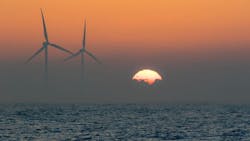Joint industry projects bring standardization across floating wind sector
Editor's note: This feature first appeared within the 2024 Offshore Wind Special Report and published within the July/August issue of Offshore magazine.
By Sigurd Solheim Pettersen, Bente Pretlove and Kristin Nergaard Berg, DNV
While offshore wind has experienced a decade of progress and growth, the last year has seen cost inflation, increased interest rates and supply chain bottlenecks threaten the pace of offshore wind development. However, offshore wind energy is in great demand with several American states looking to procure offshore wind energy in the first quarter of 2024. Joining the US, plans have recently been announced to develop wind off the coasts of Newfoundland and Labrador, Canada.
With two of the upcoming US Bureau of Ocean Energy Management offshore wind auctions being for waters too deep for fixed-bottom technology, floating wind has emerged as the technology developers are evaluating for their projects. Floating wind allows access to the US West Coast for offshore wind development and greater wind resources farther off the East Coast.
DNV’s Energy Transition Outlook forecasts that by 2050 17% of all accumulated offshore wind installed capacity globally will be floating offshore wind. This means that approximately 270 GW of floating offshore wind will be installed in the next 30 years. This will require about 18,000 turbines, each mounted on top of floating units weighing more than 5,000 tons and secured with so many mooring lines that if they were tied end to end they would more than wrap around the world.
While the sector presents significant opportunities, it also comes with a range of new challenges as developers consider projects further offshore in deeper waters. This growing market is still in its relative infancy, and for floating offshore wind to achieve its full potential, there are a number of challenges to overcome, including technical, commercial and societal.
Driving standardization to support reduced LCOE
As a relatively new technology with few operational turbines, the levelized cost of energy (LCOE) for floating offshore wind remains very high. For this technology to scale faster, it is paramount that the LCOE is reduced as much and as quickly as possible. DNV's Energy Transition Outlook forecasts that the global average LCOE for floating offshore wind will fall 75% by 2050. This drop will depend on factors like cumulative installed capacity, economies of scale and serial manufacturing, with reductions in the cost of floating structures and turbines being the main contributors. In addition, LCOE will vary significantly between global regions. DNV expects wind farm size increases to be a key driver of LCOE reduction, as moving from pilot to commercial-sized wind farms allows for scaling effects and standardization, which again will become a key enabler for industrialization, which will further drive cost reduction post 2030.
More than 50 floating wind concepts are currently under development. While innovation is required to push performance, reduce weight, withstand harsh environmental conditions and allow efficient operations, the wide range of concepts can also represent a barrier for the cost reduction needed in the industry to eventually attract subsidy-free investment. The number of different fabrication approaches can make it difficult for the supply chain to provide efficient fabrication facilities and standardize their logistics and processes.
One key area in which DNV is looking to tackle the challenges to expand application, scale and reduce costs without compromising safety is through leading joint industry projects (JIPs), ultimately aiming to bring standardization across the floating offshore wind industry.
Floating wind farms farther from shore in deeper waters will require floating substations, development of dynamic cables with higher voltage and power levels than currently available, and electrical equipment such as transformers and switchgear. DNV has initiated a JIP aimed at aligning best practice and closing the gaps in available substation standards, enabling the scaling of floating offshore wind. Phase 1 has just been completed and confirmed the feasibility of floating offshore substations and export cables, identifying technology gaps and highlighting the maturity of AC solutions compared to DC. For Phase 2, new participants are called in to join the project, which will contribute to the 2024 update of industry standards for offshore substations and dynamic high-voltage export cables.
DNV is also pursuing a JIP focused on mooring and cables. The growing floating offshore wind industry will require innovative solutions for floating structures, mooring arrangements, cable solutions and materials. Mooring and cable equipment is a key cost driver within floating wind. A key task of the JIP is to provide new and valuable insights on load and capacity of these critical components and the recommendations will form the basis for tomorrow’s design requirements.
Finally, a new JIP called Concrete FLOW was recently launched, and it aims to optimize requirements for concrete floaters, specifically tailored for floating offshore wind farms. DNV sees concrete floaters as a cost-effective and environmentally friendly alternative to steel floaters, particularly for larger turbine sizes. Plus, as an alternative to steel, concrete engages a larger part of the supply chain in floating wind.
Ocean stakeholder collaboration
As offshore wind picks up pace, the demand for ocean space will also increase. It is essential that this expansion takes place in a safe, equitable and sustainable manner. Therefore, it is critical that ocean stakeholders build strong working foundations. DNV is facilitating this through a three-year project called MARine CO-existence scenario building (MARCO).
The project aims to develop a scalable system model toolbox for determining and forecasting marine coexistence between different users of the ocean and marine ecosystems. The partners include offshore wind developer Mainstream Renewable Power, the Norwegian Institute of Marine Research, and the Norwegian Fishermen’s Association.
The DNV-led innovation project will focus on establishing a common knowledge base among ocean stakeholders, enabling them to identify synergies, resolve conflicts and negotiate win-win solutions while safeguarding ocean health. The Utsira Nord floating offshore wind licensing area in Norway will act as one of the case studies in the development of the toolbox. The toolbox will be developed in a way that allows for scaling and adaptation to different regions and international settings, including the North American market.
Future marine spatial planning processes will increasingly need to emphasize coexistence with nature and other human activities. The MARCO toolbox will help offshore field developers and operators gain a competitive advantage by more quickly understanding how future competition for space will influence their overall risks and opportunities in relation to other ocean users as well as the marine ecosystem. It will support strategic planning and stakeholder dialogues in connection with offshore field developments, marine spatial planning and ecosystem management.
As part of the project, partners will seek to capture the impact ocean industries have on each other and the environment, as well as the cumulative effects from all industries combined. MARCO aims to contribute to trust and transparency in stakeholder dialogues in the early stages of project planning. The MARCO toolbox will provide new methods that enable offshore wind developers to plan for coexistence, by taking a collaborative approach to accounting for the impact of future uncertainty on nature and the blue economy. Done right, floating offshore wind could play a less intrusive role when it comes to potential overlap with the interest of other stakeholders (e.g., not conflicting with fishing banks).
Supporting a clean energy future
To reach ambitious floating offshore wind targets, the industry must accelerate commercialization while managing risks related to cost, technical novelty, acceptance by other ocean stakeholders and environmental impacts.
In the next five years, DNV expects continued technology development in floating wind to reduce cost, scale production and broaden applicability. The European floating wind farms Hywind Tampen in Norway, Kincardine and Hywind Scotland in the UK and WindFloat Atlantic in Portugal, are operating, proving that the technology is technically feasible. Hywind Scotland, in operation since 2017, has achieved the highest average capacity factor of all offshore wind farms in the UK, indicating that floating wind can perform as well as, or better than, bottom-fixed offshore wind. Floating wind farms of larger sizes are being planned in Korea, Europe and the US.
As an increasing number of floating wind turbines come into operation, the industry will learn more about day-to-day operations, wind turbine performance and events such as major component replacement. Those learnings will undoubtedly spur new developments.
As the move toward commercialization ramps up, floating offshore wind is opening new possibilities for wind power locations and will play an important role in the transition to a cleaner energy supply.
About the Author

Sigurd Solheim Pettersen
Sigurd Solheim Pettersen is a senior researcher with DNV. He has held this position since March 2020.
Prior to this role, he served as a senior engineer with Forsvarsmateriell, a Norwegian defense materiel agency, for one year.
He obtained a PhD in marine systems design in 2018 from Norwegian University of Science and Technology (NTNU).

Bente Pretlove
Bente Pretlove is the program director for Ocean Space and Sustainable Food Systems with DNV Group Research and Development. In this role, she manages DNV's research efforts related to the sustainable development of ocean-based industries, ocean health and global food systems. She has served in various roles with DNV since 1998.
She is a member of the Norwegian national committee for the UN Ocean Decade and has been a member of the international UN Ocean Decade Advisory Board (IOC-UNESCO) for two years. She is DNV's point of contact for the UN Global Compact Ocean Stewardship coalition and has also held the position as vice chair for Blue Growth in the EU technology platform Waterborne.

Kristin Nergaard Berg
Kristin Nergaard Berg is the technical lead for DNV's Floating Offshore Wind, Energy Systems. She has served in various roles with the company since October 2008.
She has broad experience from the energy industry since 2001 that includes product development; cross discipline project management; technology qualification; risk management and verification; offshore wind; subsea technology; people management and P&L responsibility; technology markets and strategy; and sales, marketing and customer centricity.
